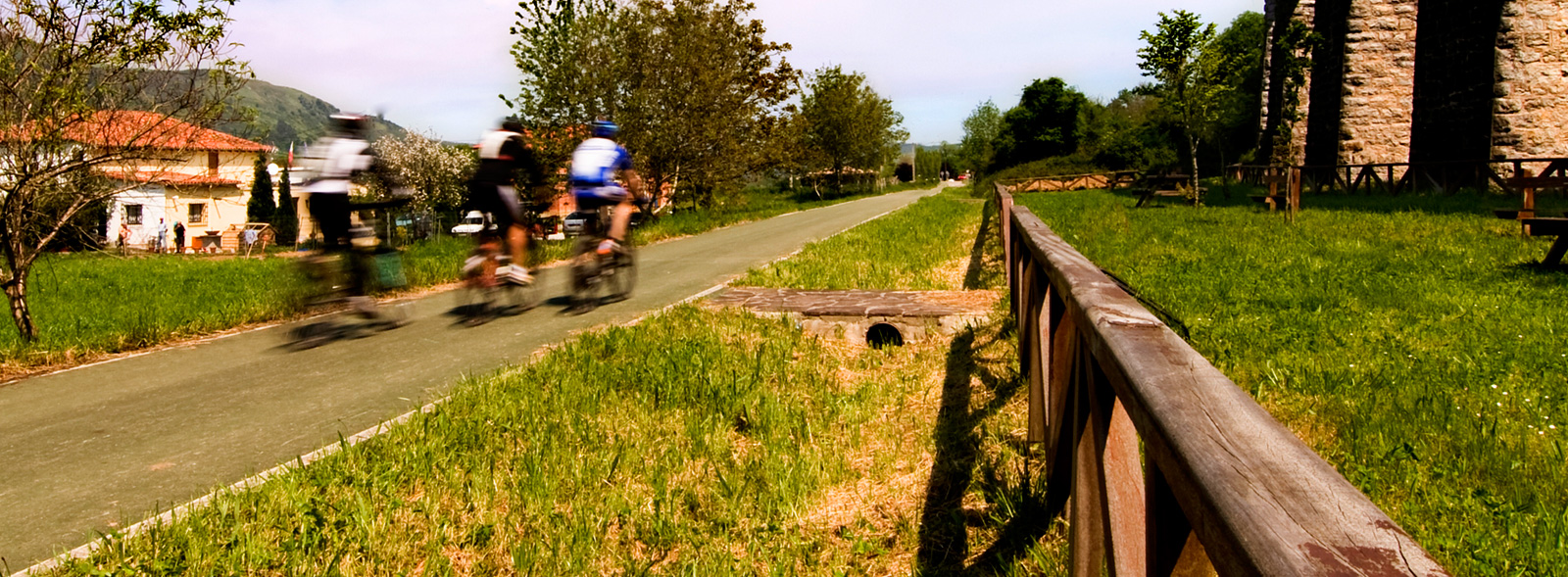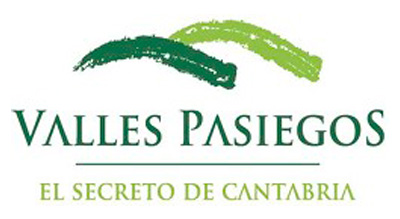Pas Greenway Nature Trail
Route Description
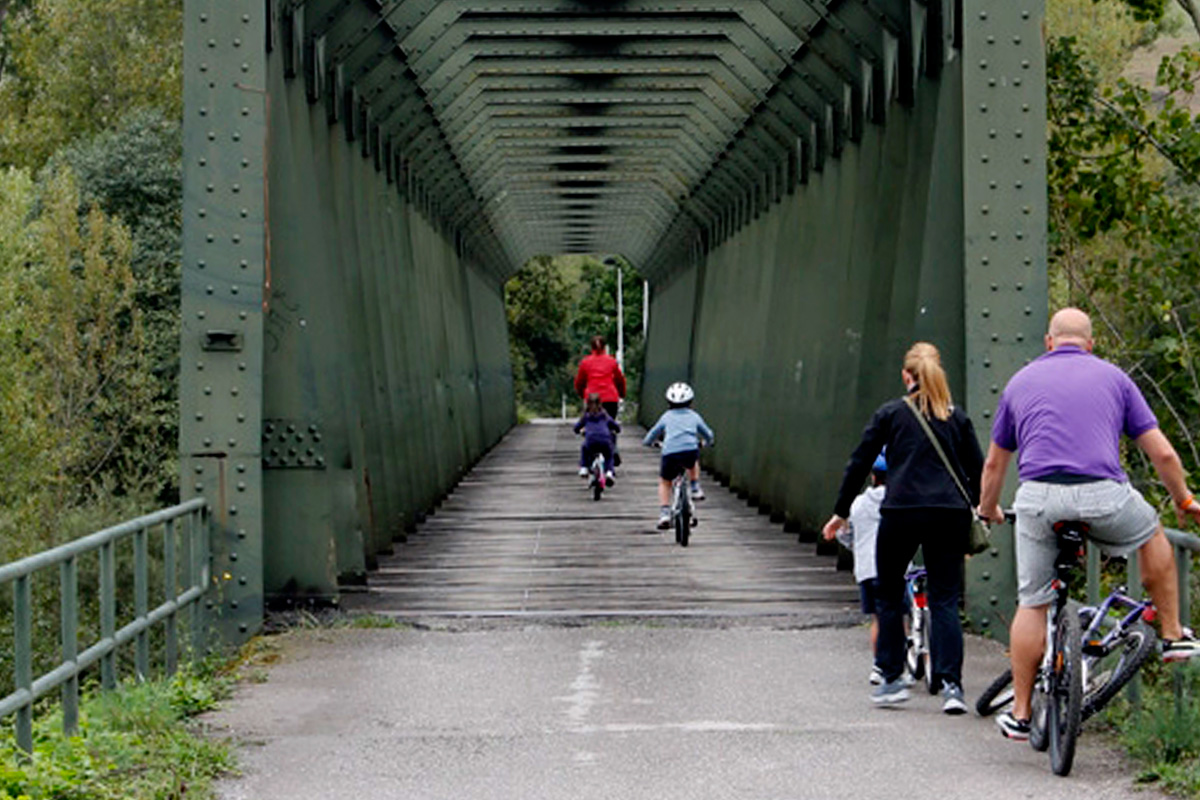 The itinerary consists of two different sections. At its ends (between Alceda-Ontaneda and San Vicente de Toranzo and between Astillero and Obregón) the greenway has been completely upgraded. Between the two there are other upgraded sections, although without specific signage. These are located around the Viesgo Bridge, Sarón and La Penilla. In addition, there is a section of greenway that was still being upgraded at the time of publication of this guide (2021), obliging us to travel along the hard shoulder of a regional road and go through an urban area (between the municipal district of Penagos and the town of Sarón).
The itinerary consists of two different sections. At its ends (between Alceda-Ontaneda and San Vicente de Toranzo and between Astillero and Obregón) the greenway has been completely upgraded. Between the two there are other upgraded sections, although without specific signage. These are located around the Viesgo Bridge, Sarón and La Penilla. In addition, there is a section of greenway that was still being upgraded at the time of publication of this guide (2021), obliging us to travel along the hard shoulder of a regional road and go through an urban area (between the municipal district of Penagos and the town of Sarón).
The Ontaneda Circuit
The first section starts in the town of Ontaneda, at the foot of the El Escudo pass. We recommend starting in this place, as this way you can take advantage of the gentle downhill slope that, in 34 km, will take the traveller from a height of 178 metres in Ontaneda to sea level. Located in this town, we will look for the old station, now converted into a tourist office. The road is integrated into this area’s urban road network. A slight change in the colour of the asphalt together with some signs of the route indicate the greenway’s itinerary.
We will head north and, after a short urban section, we will arrive in less than a kilometre to the streets of San Vicente de Toranzo. At km 2, we come across a timber processing plant that the road avoids by approaching the Pas riverbed alongside the cemetery. At this point, the Ontaneda Circuit, a circular itinerary that takes advantage of part of the greenway, would enable us to return by going up the Pas Valley, as far as Ontaneda, specifically next to the Alceda estate, where a spa is located. After skirting the thermal facility, we arrive again at Ontaneda Station.
From the iron bridge to the Franciscans in Soto
However, our suggested itinerary does not return to Ontaneda but continues along the original railway route to Santander. We come to the first iron bridge that crosses the Pas Valley. This iron framework will get us across to the opposite bank and enable us to take some picturesque photos of this spot.
The asphalted section continues as far as the San Martín hut and stop. Thereafter we will enter an area that features some of the most beautiful places on the way to Santiurde (km 6), the municipal capital. After passing the village, on the right of the greenway, you will be surprised to see an impressive series of stone arches. This formed part of an aqueduct carrying an old (and abandoned) water pipe that used to cross the terrain in this elegant way.
The greenway continues parallel to the road. This section features in the horizon the Renaissance tower of the Franciscan convent in Soto, which, like a watchtower, watches over the region of the Pas Valley. In Soto we will have to get around –we ask for a little patience– a couple of greenway closures. We can make the most of the first one to visit this quiet village’s streets. Its station, located at km 9, still stands at the foot of the tower. After the station we will come across the second closure, so we will have to go up to the right to take, in about 300 metres, the road to La Penilla. Be very careful! On this road we will pass by the church and then an underpass that enables us to continue safely on our way.
Fountain of health in Puente Viesgo
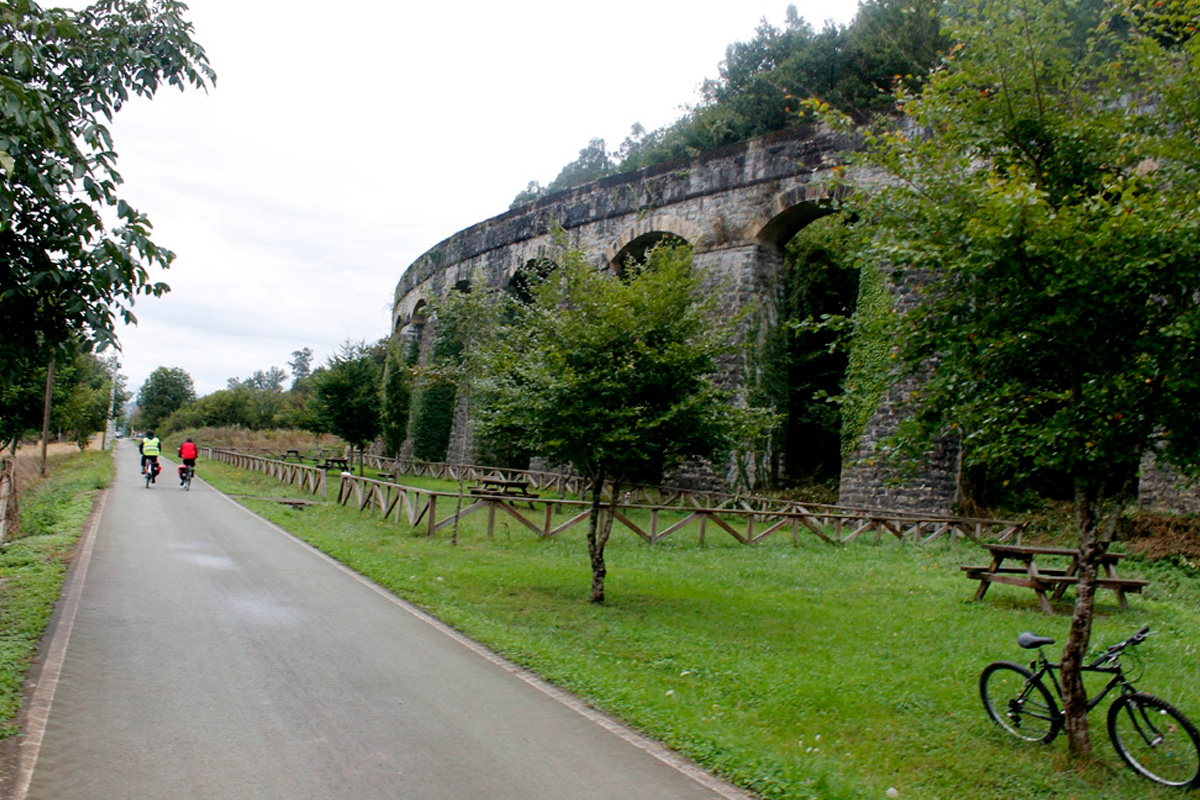 After La Penilla we will approach a section where a quarry has cut off part of the mountain, slightly dirtying the landscape. Once we have passed the cut, we will be able to observe the waters of the River Pas a few metres away, splashing against some small dikes. In this same area it is worth stopping to contemplate an old washing place located on the side of the greenway that, although it has lost its original function, maintains the charm of the rural world’s recent past. Here an area has also been prepared for the little ones to play and the older ones to rest, with the sound of the river in the background.
After La Penilla we will approach a section where a quarry has cut off part of the mountain, slightly dirtying the landscape. Once we have passed the cut, we will be able to observe the waters of the River Pas a few metres away, splashing against some small dikes. In this same area it is worth stopping to contemplate an old washing place located on the side of the greenway that, although it has lost its original function, maintains the charm of the rural world’s recent past. Here an area has also been prepared for the little ones to play and the older ones to rest, with the sound of the river in the background.
We arrive at Puente Viesgo Station (km 12), the most elegant one along this greenway. Today it houses the municipal tourist office and the visitor centre of the Natura 2000 Network. The station’s passenger building has been impeccably preserved, featuring a distinguished porch and even its platform clock. The proximity of a nursing home and the famous spa of Puente Viesgo to this station will make this a very busy section.
Before continuing, we must stop in front of "La Reyerta," the elegant narrow-gauge steam locomotive. This model 030-T engine was built in Munich in 1912. And it was operational until the 1970s. It will be easy to play stoker for a day and dream of those trains of yesteryear. Puente Viesgo bids farewell to the visitor next to its charming neo-Romanesque church erected in the twentieth century.
Through the Pisueña Valley towards Obregón
The greenway takes us to the Pisueña River, which we will cross by a concrete bridge. On the other side of the river we arrive at Pomaluengo (km 17) and the N-634, a road that will be our travelling companion to Sarón. We must cross this busy road very carefully and, on the other side, after the village houses, the greenway appears again. We can travel along it peacefully without the presence of cars, which roar by along the neighbouring road.
In this urban section we should look out for a white building located on the right of the greenway. It is the former Pomaluengo Station, which has now been converted into the Castañeda Cultural Association of the Elderly.
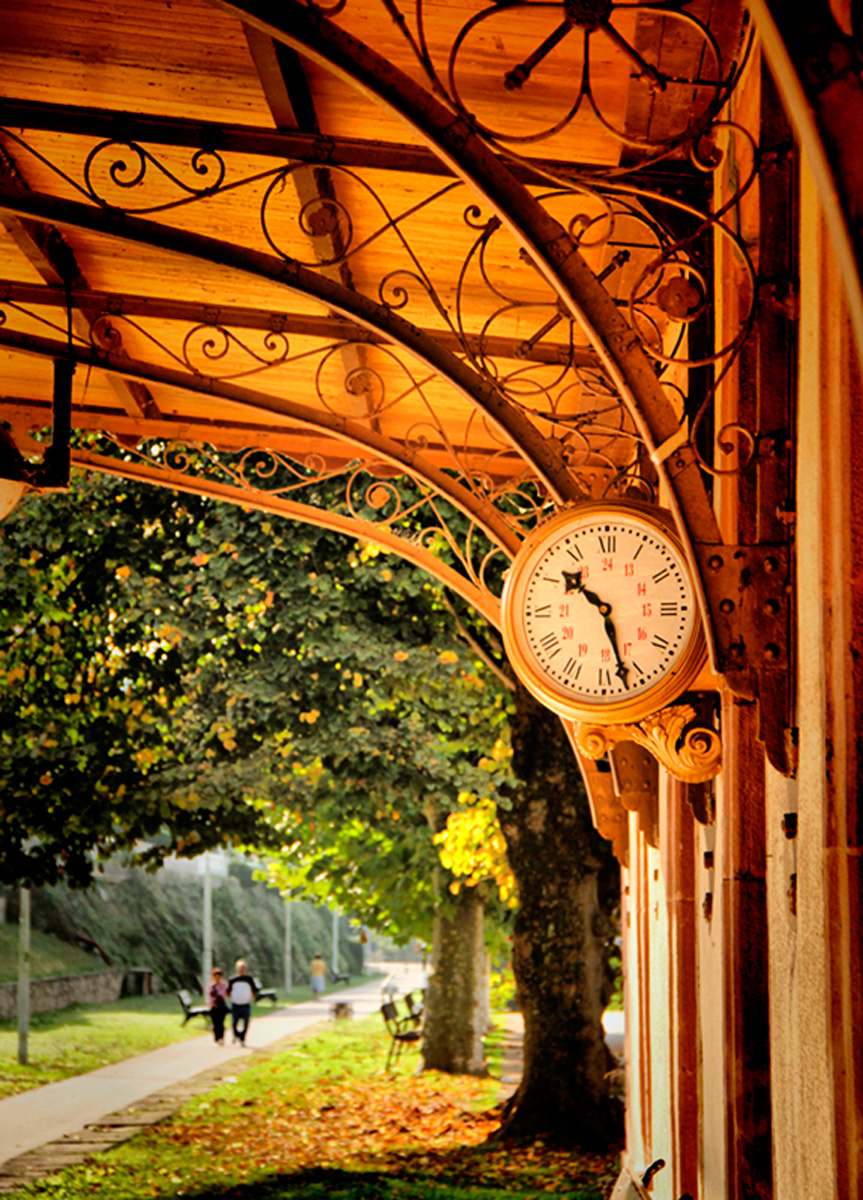 A little further on, after a long straight stretch, the greenway runs parallel to the road until it crosses it. We continue on the dirt track in a straight line bordered by trees until the next village, La Penilla (this is not a mistake: the same place name is used again), where the presence of a tree-lined walk indicates that we are going to pass through the site where the village station was once located.
A little further on, after a long straight stretch, the greenway runs parallel to the road until it crosses it. We continue on the dirt track in a straight line bordered by trees until the next village, La Penilla (this is not a mistake: the same place name is used again), where the presence of a tree-lined walk indicates that we are going to pass through the site where the village station was once located.
We will leave La Penilla through a green space that gradually narrows between the road and the calm Pisueña River. The greenway makes its way through another very pleasant section to La Encina along a tree-lined path that passes next to the old Torrentero or La Campanilla mill and leads us to Sarón (km 23).
This place is, for now, the end of the route. If we want to continue along the Pisueña Valley, we have to do so by road, following the signs for Obregón, Santander or Cabárceno. To the right of this road you will see the remains of the Ontaneda railway. It is a section in which special caution is recommended since we have to travel along a road.
A greenway to the Bay of Santander
If you decide to continue on from Sarón, you should know that you leave the unattractive road at the first turn-off along the CA-405 towards Sobarzo and Penagos to take, after 200 metres, a dirt track to the left where there is a sign prohibiting motor vehicles. Following it, we connect with the asphalted greenway that leads to the village of Obregón (km 26). We will cross this village to come back out to the road coming up from Sarón, until we leave it once and for all at the entrance to Cabárceno Park. In the park's outdoor car park, next to the information booth, there begins a new 6.3-km section going down towards the sea along a trail reserved for cyclists and trekkers, featuring fountains, rest areas and all the greenways’ characteristic elements. We thereby descend through woodland and farmland that alternate with meadows where cows graze meekly on the slopes of Peña Cabarga.
At the beginning of this relaxing walk we will follow the route of another railway, which was a mining railroad with a smaller gauge that was used to access Cabárceno’s mining area.
On this route we will pass by the restored La Concha Station (km 29) before finally reaching Ría de Solía in the Bay of Santander. This natural landscape is crossed by an old metal railway bridge, after which the greenway heads towards the houses of Astillero (km 34), which marks the end of this unique route. In this town, Feve trains, now integrated into the Renfe "brand," make it easier for us to reach the delightful capital of Cantabria, thus evoking the train passengers that used to come from the Pas Valley. It is worth visiting the Orconera loading dock, which has been declared a Site of Local Interest.
